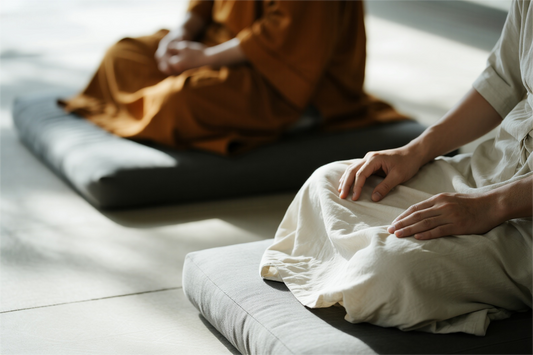
Introduction: Harmony Before Expression
“Before joy, anger, sorrow, and pleasure arise, that is called the Mean. When these emotions are expressed with appropriate moderation, that is called Harmony.”
— The Doctrine of the Mean
In this subtle yet powerful passage from a Confucian classic, we are reminded that true balance lies not in suppressing emotion, but in cultivating awareness before reaction. This teaching, known as the Doctrine of the Mean, or Zhong Yong, represents one of the highest forms of wisdom in Chinese philosophy—yet it is often misunderstood as passivity or compromise.
In reality, the Doctrine of the Mean is a dynamic principle of internal and external balance. It is not about standing in the middle for the sake of neutrality, but about knowing when to act, how much to say, and what kind of energy to bring to each moment.
In a world increasingly defined by extremes—ideological, emotional, digital—the revival of this ancient wisdom offers a powerful guide to living with purpose, clarity, and inner peace.
I. What Is the Doctrine of the Mean?
The Doctrine of the Mean is one of the Four Books of Confucianism and serves as both a moral philosophy and a psychological insight. It suggests that:
-
Every person is born with the potential for harmony
-
Emotions are not wrong, but must be expressed in the right measure
-
Virtue lies in balance—not excess or deficiency
This equilibrium applies to all aspects of life:
-
In speech: speaking with honesty, but not harshness
-
In behavior: showing confidence, without arrogance
-
In emotion: acknowledging feelings without letting them dictate our lives
At its core, the Mean is about conscious response rather than automatic reaction. It requires mindfulness, restraint, and above all, self-knowledge.
II. Balance Is Not Compromise—It Is Mastery
Modern society often values boldness, confrontation, and immediate reaction. Social media rewards extremes—loud opinions, emotional outbursts, instant judgments. In this context, balance can seem like weakness or indecision.
But the Doctrine of the Mean reveals that true balance is strength.
It means:
-
Choosing timing over urgency
-
Responding with intention, not impulse
-
Pausing before replying
-
Listening deeply before assuming
In personal growth, it means holding ambition without anxiety. In leadership, it means having vision without dominance. In relationships, it means loving without clinging.
The balanced person is not indifferent—they are discerning. They feel everything, but they are not ruled by anything. That is mastery.

III. The Inner-Outer Connection: Aligning Self with the World
The beauty of Zhong Yong lies in its insistence on alignment between internal state and external action. It teaches that to create harmony in the world, one must first cultivate harmony within.
This concept is especially powerful in high-pressure environments:
-
In careers, it prevents burnout by encouraging sustainable pace
-
In parenting, it replaces control with understanding
-
In partnerships, it fosters mutual respect over emotional turbulence
Balance does not mean suppressing your identity. It means refining your energy so that it flows with purpose. Like tuning an instrument, you adjust until the tone is clear—not too soft, not too loud.
IV. The Wisdom of the Middle Way in Today’s World
In global business, politics, and even spirituality, we see the pendulum swing rapidly between extremes: overwork vs. “quiet quitting,” indulgence vs. asceticism, control vs. chaos.
The Doctrine of the Mean invites us to pause and ask:
-
Is this decision rooted in fear or wisdom?
-
Am I reacting or responding?
-
Is my pace sustainable?
-
Does this path preserve my integrity and well-being?
In the workplace:
-
It promotes thoughtful leadership, not micromanagement
-
It supports empathetic collaboration rather than competitive aggression
-
It encourages reflective decision-making, not reactive firefighting
In emotional life:
-
It provides tools for emotional regulation
-
Helps individuals sit with discomfort without suppressing it
-
Teaches how to name, hold, and release emotion without becoming it
In short: balance is not neutrality—it is ethical clarity in motion.

V. Cultivating Balance as a Daily Practice
Like all virtue, balance is not a trait we are born with, but a skill we must practice. The Doctrine of the Mean provides no strict rules—only principles. And like walking a tightrope, it requires constant attention to inner signals and outer cues.
Practical ways to apply this wisdom include:
-
Daily reflection: journaling moments when you overreacted or withdrew
-
Meditative stillness: learning to observe emotion before responding
-
Clear boundaries: knowing when to say yes, when to say no, and when to pause
-
Balanced routines: blending effort and rest, solitude and connection, speaking and listening
The result is a more integrated life—where what we think, feel, and do are in harmony.
Conclusion: In the Center, There Is Power
“Before emotions arise, that is the Mean. When expressed with harmony, that is peace.”
— The Doctrine of the Mean
This timeless principle reminds us that in stillness lies strength. In gentleness lies clarity. In balance lies freedom.
We do not need to live at the mercy of mood swings, social chaos, or extreme identities. We can cultivate a center—a quiet, stable point from which all good action flows.
In the modern world, where algorithms demand immediacy and emotions are commodified for attention, the ancient voice of the Doctrine of the Mean whispers something revolutionary:
Be centered. Be calm. Be measured. Be whole.




